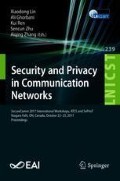Abstract
We present a Side-Channel Analysis Platform (SCAP) Framework developed to acquire and study the traces derived from a cryptographic device when cryptographic computations are done. The main goal of this work is to develop a tool for performing side-channel attacks against these cryptographic devices. The characteristics of the SCAP Framework are described and a case study with a smartphone is presented.
Access this chapter
Tax calculation will be finalised at checkout
Purchases are for personal use only
References
Rivest, R., Shamir, A., Adleman, L.: A method for obtaining digital signatures and public-key cryptosystems. Commun. ACM 21(2), 120–126 (1978)
Hankerson, D., Menezes, A., Vanstone, S.: Guide to Elliptic Curve Cryptography. Springer, New York (2004). https://doi.org/10.1007/b97644
Kocher, P.C.: Timing attacks on implementations of Diffie-Hellman, RSA, DSS, and other systems. In: Koblitz, N. (ed.) CRYPTO 1996. LNCS, vol. 1109, pp. 104–113. Springer, Heidelberg (1996). https://doi.org/10.1007/3-540-68697-5_9
Wold, K., Petrovic, S.: Behavioral model of TRNG based on oscillator rings implemented in FPGA. In: Proceedings of the \(14^{th}\) IEEE International Symposium on Design and Diagnostics of Electronic Circuits Systems (DDECS), pp. 163–166 (2011)
Moradi, A., Kasper, M., Paar, C.: Black-box side-channel attacks highlight the importance of countermeasures. In: Dunkelman, O. (ed.) CT-RSA 2012. LNCS, vol. 7178, pp. 1–18. Springer, Heidelberg (2012). https://doi.org/10.1007/978-3-642-27954-6_1
De Mulder, E., Örs, S.B., Preneel, B., Verbauwhede, I.: Differential power and electromagnetic attacks on a FPGA implementation of elliptic curve cryptosystems. Comput. Electr. Eng. 33(5–6), 367–382 (2007)
Sun, S., Yan, Z., Zambreno, J.: Experiments in attacking FPGA-based embedded systems using differential power analysis. In: Proceedings of the IEEE International Conference on Electro/Information Technology (EIT), pp. 7–12 (2008)
Kocher, P., Jaffe, J., Jun, B., Rohatgi, P.: Introduction to differential power analysis. J. Cryptogr. Eng. 1, 5–27 (2011)
Mangard, S.: Exploiting radiated emissions-EM attacks on cryptographic ICs. In: 2003 Proceedings of Austrochip, pp. 13–16 (2003)
Genkin, D., Pachmanov, L., Pipman, I., Tromer, E.: Stealing keys from PCs using a radio: cheap electromagnetic attacks on windowed exponentiation. In: Güneysu, T., Handschuh, H. (eds.) CHES 2015. LNCS, vol. 9293, pp. 207–228. Springer, Heidelberg (2015). https://doi.org/10.1007/978-3-662-48324-4_11. https://eprint.iacr.org/2015/170.pdf
Hutter, M., Schmidt, J.-M.: The temperature side channel and heating fault attacks. In: Francillon, A., Rohatgi, P. (eds.) CARDIS 2013. LNCS, vol. 8419, pp. 219–235. Springer, Cham (2014). https://doi.org/10.1007/978-3-319-08302-5_15. https://eprint.iacr.org/2014/190.pdf
Genkin, D., Shamir, A., Tromer, E.: RSA key extraction via low-bandwidth acoustic cryptanalysis. In: Garay, J.A., Gennaro, R. (eds.) CRYPTO 2014. LNCS, vol. 8616, pp. 444–461. Springer, Heidelberg (2014). https://doi.org/10.1007/978-3-662-44371-2_25. https://www.cs.tau.ac.il/~tromer/papers/acoustic-20131218.pdf
Joye, M., Tunstall, M. (eds.): Fault Analysis in Cryptography. Springer publishing, Heidelberg (2012). https://doi.org/10.1007/978-3-642-29656-7
Anderson, R., Bond, M., Clulow, J., Skorobogatov, S.: Cryptographic processors-a survey. Proc. IEEE 94(2), 357–369 (2006)
Skorobogatov, S.: Semi-invasive attacks-a new approach to hardware security analysis. Ph.D. thesis, University of Cambridge, Darwin College, UK (2005). http://www.cl.cam.ac.uk/techreports/UCAM-CL-TR-630.pdf
Kerckhoffs, A.: La cryptographie militaire. J. des Sci. Militaires IX, 1–2, 5–38, 161–191 (1883)
Kocher, P., Jaffe, J., Jun, B.: Differential power analysis. In: Wiener, M. (ed.) CRYPTO 1999. LNCS, vol. 1666, pp. 388–397. Springer, Heidelberg (1999). https://doi.org/10.1007/3-540-48405-1_25
Brier, E., Clavier, C., Olivier, F.: Correlation power analysis with a leakage model. In: Joye, M., Quisquater, J.-J. (eds.) CHES 2004. LNCS, vol. 3156, pp. 16–29. Springer, Heidelberg (2004). https://doi.org/10.1007/978-3-540-28632-5_2
Mangard, S., Oswald, E., Popp, T.: Power Analysis Attacks: Revealing the Secrets of Smart Cards. Advances in Information Security. Springer Science+Business Media, Heidelberg (2007). https://doi.org/10.1007/978-0-387-38162-6
Quisquater, J.-J., Samyde, D.: Electro magnetic analysis (EMA): measures and counter-measures for smart cards. In: Attali, I., Jensen, T. (eds.) E-smart 2001. LNCS, vol. 2140, pp. 200–210. Springer, Heidelberg (2001). https://doi.org/10.1007/3-540-45418-7_17
Genkin, D., Pipman, I., Tromer, E.: Get your hands off my laptop: physical side-channel key-extraction attacks on PCs. J. Cryptogr. Eng. 5(2), 95–112 (2015). http://link.springer.com/content/pdf/10.1007%2Fs13389-015-0100-7.pdf
Agrawal, D., Rao, J.R., Rohatgi, P.: Multi-channel attacks. In: Walter, C.D., Koç, Ç.K., Paar, C. (eds.) CHES 2003. LNCS, vol. 2779, pp. 2–16. Springer, Heidelberg (2003). https://doi.org/10.1007/978-3-540-45238-6_2
Nakano, Y., Souissi, Y., Nguyen, R., Sauvage, L., Danger, J.-L., Guilley, S., Kiyomoto, S., Miyake, Y.: A pre-processing composition for secret key recovery on android smartphone. In: Naccache, D., Sauveron, D. (eds.) WISTP 2014. LNCS, vol. 8501, pp. 76–91. Springer, Heidelberg (2014). https://doi.org/10.1007/978-3-662-43826-8_6. https://hal.inria.fr/hal-01400921
Goller, G., Sigl, G.: Side channel attacks on smartphones and embedded devices using standard radio equipment. In: Mangard, S., Poschmann, A.Y. (eds.) COSADE 2014. LNCS, vol. 9064, pp. 255–270. Springer, Cham (2015). https://doi.org/10.1007/978-3-319-21476-4_17
Belgarric, P., Fouque, P.A., Macario-Rat, G., Tibouchi, M.: Side-channel analysis of Weierstrass and Koblitz curve ECDSA on android smartphones. Cryptology ePrint Archive, Report 2016/231, pp. 1–26 (2016). https://eprint.iacr.org/2016/231.pdf
Belgarric, P., Fouque, P.-A., Macario-Rat, G., Tibouchi, M.: Side-channel analysis of Weierstrass and Koblitz curve ECDSA on android smartphones. In: Sako, K. (ed.) CT-RSA 2016. LNCS, vol. 9610, pp. 236–252. Springer, Cham (2016). https://doi.org/10.1007/978-3-319-29485-8_14
Genkin, D., Pachmanov, L., Pipman, I., Tromer, E., Yarom, Y.: ECDSA key extraction from mobile devices via nonintrusive physical side channels. Cryptology ePrint Archive, Report 2016/230, pp. 1–23 (2016). https://eprint.iacr.org/2016/230.pdf
Acknowledgments
This work has been partly supported by Ministerio de Economía y Competitividad (Spain) under the projects TIN2014-55325-C2-1-R (ProCriCiS), TIN2013-46469-R (SPINY), TIN2016-79095-C2-2-R (SMOG-DEV), and by Comunidad de Madrid (Spain) under the project S2013/ICE-3095-CM (CIBERDINE), cofinanced with the European Union FEDER funds. We thank National Instruments for its support.
Author information
Authors and Affiliations
Corresponding author
Editor information
Editors and Affiliations
Rights and permissions
Copyright information
© 2018 ICST Institute for Computer Sciences, Social Informatics and Telecommunications Engineering
About this paper
Cite this paper
Blanco Blanco, A. et al. (2018). A Framework for Acquiring and Analyzing Traces from Cryptographic Devices. In: Lin, X., Ghorbani, A., Ren, K., Zhu, S., Zhang, A. (eds) Security and Privacy in Communication Networks. SecureComm 2017. Lecture Notes of the Institute for Computer Sciences, Social Informatics and Telecommunications Engineering, vol 239. Springer, Cham. https://doi.org/10.1007/978-3-319-78816-6_20
Download citation
DOI: https://doi.org/10.1007/978-3-319-78816-6_20
Published:
Publisher Name: Springer, Cham
Print ISBN: 978-3-319-78815-9
Online ISBN: 978-3-319-78816-6
eBook Packages: Computer ScienceComputer Science (R0)

